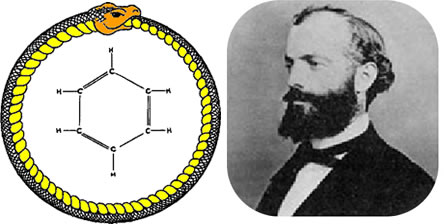Thomas Pynchon's in a Paragraph - Gravity's Rainbow
“Kekulé dreams the Great Serpent holding its own tail in its mouth, the dreaming Serpent which surrounds the World. But the meanness, the cynicism with which this dream is to be used. The Serpent that announces, "The World is a closed thing, cyclical, resonant, eternally-returning," is to be delivered into a system whose only aim is to violate the Cycle. Taking and not giving back, demanding that "productivity" and "earnings" keep on increasing with time, the System removing from the rest of the World these vast quantities of energy to keep its own tiny desperate fraction showing a profit: and not only most of humanity—most of the World, animal, vegetable, and mineral, is laid waste in the process. The System may or may not understand that it's only buying time. And that time is an artificial resource to begin with, of no value to anyone or anything but the System, which must sooner or later crash to its death, when its addiction to energy has become more than the rest of the World can supply, dragging with it innocent souls all along the chain of life. Living inside the System is like riding across the country in a bus driven by a maniac bent on suicide . . . though he's amiable enough, keeps cracking jokes back through the loudspeaker . . .”
The above passage from the paragraph describes a dream of the Ouroboros had by August Kekule, as imagined by Pynchon. Kekule is credited with discovering the benzene hydrocarbon structure, and here is a short story of his relation to the Ouroboros and how it influenced him.
Physicist Hans von Baeyer tells a strange story about the benzene molecule. It begins in 1850 with a young architecture student, Friedrich Kekule, testifying before a grand jury in Giessen, Germany. The charred body of a neighbor lady had been found in her room. People thought she'd been the victim of spontaneous combustion, brought on by drinking too much liquor.
The great chemist Justus von Liebig testified at the trial. He made it quite clear that the lady would have died long before she'd drunk enough alcohol to make her flammable. Then Kekule's testimony incriminated a servant who'd been stealing from the lady. He identified her distinctive ring, which turned up in the servant's possession. Together, Liebig's and Kekule's testimony convicted the scoundrel of murdering the lady.
The trial left its mark on the young Kekule. He gave up architecture and took up the study of chemistry with Liebig. The lady's odd ring also lingered in Kekule's mind -- it had carried the old alchemy seal of two intertwined serpents biting each other's tail.
Fifteen years later, Kekule worked with Liebig on a new chemical called benzene. Logic dictated that it must be an arrangement of six carbon, and six hydrogen, atoms. But how could you arrange such a molecule without violating the rules of chemical valence? It didn't seem possible.
Kekule dozed in his chair by the fire, trying to solve the riddle. As he nodded, he dreamt of the twining serpents on that old ring, whirling in the flames. Suddenly, in the dream, the serpents caught each other's tail and formed a circle. Kekule saw the answer. The carbon atoms formed an hexagonal ring with alternating single and double bonds. Each one held its own hydrogen atom -- "like charms on a bracelet," says von Baeyer. It was a structure utterly alien to anything else in chemistry.
http://www.uh.edu/engines/epi265.htm
Justus von Liebig is considered to be the father of modern organic chemistry, and it is from him that Kekule derives his inspiration. From Wiki:
Justus Freiherr von Liebig[2] (12 May 1803 – 18 April 1873) was a German chemist who made major contributions to agricultural and biologicalchemistry, and was considered the founder of organic chemistry.[3] As a professor at the University of Giessen, he devised the modern laboratory-oriented teaching method, and for such innovations, he is regarded one of the greatest chemistry teachers of all time.[4] He is considered the "father of the fertilizer industry" for his emphasis on nitrogen and certain minerals as essential plant nutrients, and his formulation of the Law of the Minimum which described the effect of individual nutrients on crops.[5] He also developed a manufacturing process for beef extracts, and founded a company, Liebig Extract of Meat Company, that later trademarked the Oxo brand beef bouillon cube.
More on this later in part two. I will connect the idea of the Ouroboros and a later quote in the second part of the paragraph which relates to the Phoenix. Cheers.

















